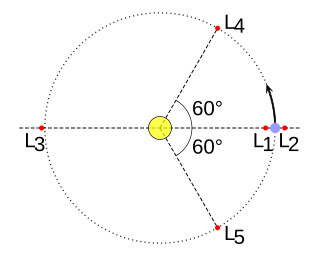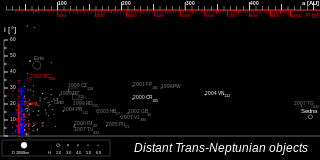Related Research Articles
In astronomy, the plutinos are a dynamical group of trans-Neptunian objects that orbit in 2:3 mean-motion resonance with Neptune. This means that for every two orbits a plutino makes, Neptune orbits three times. The dwarf planet Pluto is the largest member as well as the namesake of this group. The next largest members are Orcus, (208996) 2003 AZ84, and Ixion. Plutinos are named after mythological creatures associated with the underworld.

A trans-Neptunian object (TNO), also written transneptunian object, is any minor planet in the Solar System that orbits the Sun at a greater average distance than Neptune, which has a semi-major axis of 30.1 astronomical units (au).

A natural satellite is, in the most common usage, an astronomical body that orbits a planet, dwarf planet, or small Solar System body. Natural satellites are often colloquially referred to as moons, a derivation from the Moon of Earth.

Sedna (minor-planet designation 90377 Sedna) is a dwarf planet in the outer reaches of the Solar System that is in the innermost part of its orbit; as of 2022 it is 84 astronomical units (1.26×1010 km; 0.00041 pc) from the Sun, almost three times farther than Neptune. Spectroscopy has revealed that Sedna's surface composition is similar to those of some other trans-Neptunian objects, being largely a mixture of water, methane, and nitrogen ices with tholins. Its surface is one of the reddest among Solar System objects. To within estimated uncertainties, Sedna is tied with Ceres as the largest planetoid not known to have a moon.
Scott Sander Sheppard is an American astronomer and a discoverer of numerous moons, comets and minor planets in the outer Solar System.
(612243) 2001 QR322, prov. designation: 2001 QR322, is a minor planet and the first Neptune trojan discovered on 21 August 2001, by American astronomer Marc Buie of the Deep Ecliptic Survey at Cerro Tololo Observatory in Chile. It orbits ahead of Neptune at its L4 Lagrangian point and measures approximately 132 kilometers (82 miles) in diameter.
(148209) 2000 CR105 is a trans-Neptunian object and the tenth-most-distant known object in the Solar System as of 2015. Considered a detached object, it orbits the Sun in a highly eccentric orbit every 3,305 years at an average distance of 222 astronomical units (AU).
385571 Otrera, provisional designation 2004 UP10, is a Neptune trojan leading Neptune's orbit in the outer Solar System. It was discovered by American astronomers Scott Sheppard and Chad Trujillo at Las Campanas Observatory on 16 October 2004. It measures approximately 100 kilometers in diameter and was the second such body to be discovered after 2001 QR322.

The scattered disc (or scattered disk) is a distant circumstellar disc in the Solar System that is sparsely populated by icy small solar system bodies, which are a subset of the broader family of trans-Neptunian objects. The scattered-disc objects (SDOs) have orbital eccentricities ranging as high as 0.8, inclinations as high as 40°, and perihelia greater than 30 astronomical units (4.5×109 km; 2.8×109 mi). These extreme orbits are thought to be the result of gravitational "scattering" by the gas giants, and the objects continue to be subject to perturbation by the planet Neptune.

Neptune trojans are bodies that orbit the Sun near one of the stable Lagrangian points of Neptune, similar to the trojans of other planets. They therefore have approximately the same orbital period as Neptune and follow roughly the same orbital path. Twenty-eight Neptune trojans are currently known, of which 24 orbit near the Sun–Neptune L4 Lagrangian point 60° ahead of Neptune and four orbit near Neptune's L5 region 60° behind Neptune. The Neptune trojans are termed 'trojans' by analogy with the Jupiter trojans.
2005 TN53 is an inclined Neptune trojan leading Neptune's orbit in the outer Solar System, approximately 80 kilometers in diameter. It was first observed on 7 October 2005, by American astronomers Scott Sheppard and Chad Trujillo at Las Campanas Observatory in the Atacama desert of Chile. It was the third such body to be discovered, and the first with a significant orbital inclination, which showed that the population as a whole is very dynamically excited.

The International Astronomical Union (IAU) defined in August 2006 that, in the Solar System, a planet is a celestial body that:
- is in orbit around the Sun,
- has sufficient mass to assume hydrostatic equilibrium, and
- has "cleared the neighbourhood" around its orbit.

In astronomy, a trojan is a small celestial body (mostly asteroids) that shares the orbit of a larger body, remaining in a stable orbit approximately 60° ahead of or behind the main body near one of its Lagrangian points L4 and L5. Trojans can share the orbits of planets or of large moons.
(309239) 2007 RW10, provisionally known as 2007 RW10, is a temporary quasi-satellite of Neptune. Observed from Neptune, it would appear to go around it during one Neptunian year but it actually orbits the Sun, not Neptune.

A minor planet is an astronomical object in direct orbit around the Sun that is exclusively clasified as neither a planet nor a comet. Before 2006, the International Astronomical Union (IAU) officially used the term minor planet, but that year's meeting reclassified minor planets and comets into dwarf planets and small Solar System bodies (SSSBs).
(527604) 2007 VL305, provisional designation 2007 VL305, is an inclined Neptune trojan that shares Neptune's orbit in the L4 Lagrangian point. It was discovered on 4 November 2007, by astronomers Andrew Becker, Andrew Puckett and Jeremy Kubica at the Apache Point Observatory in New Mexico, United States, although images from 2005 have also been recovered. It measures approximately 160 kilometers in diameter and was the sixth Neptune trojan to be discovered. As of 2016, it is 34.1 AU from Neptune.

Detached objects are a dynamical class of minor planets in the outer reaches of the Solar System and belong to the broader family of trans-Neptunian objects (TNOs). These objects have orbits whose points of closest approach to the Sun (perihelion) are sufficiently distant from the gravitational influence of Neptune that they are only moderately affected by Neptune and the other known planets: This makes them appear to be "detached" from the rest of the Solar System, except for their attraction to the Sun.

An extreme trans-Neptunian object (ETNO) is a trans-Neptunian object orbiting the Sun well beyond Neptune (30 AU) in the outermost region of the Solar System. An ETNO has a large semi-major axis of at least 150–250 AU. Its orbit is much less affected by the known giant planets than all other known trans-Neptunian objects. They may, however, be influenced by gravitational interactions with a hypothetical Planet Nine, shepherding these objects into similar types of orbits. The known ETNOs exhibit a highly statistically significant asymmetry between the distributions of object pairs with small ascending and descending nodal distances that might be indicative of a response to external perturbations.
References
- ↑ Remo, John L. (2007). "Classifying Solid Planetary Bodies". AIP Conference Proceedings. 886: 284–302. doi:10.1063/1.2710063.
- ↑ J Horner; NW Evans; ME Bailey; DJ Asher (2003). "The Populations of Comet-like Bodies in the Solar System" (PDF). Archived from the original (PDF) on 2013-06-01. Retrieved 2007-06-29.
- ↑ "List Of Neptune Trojans". Minor Planet Center. Archived from the original on 2012-05-25. Retrieved 2010-10-27.